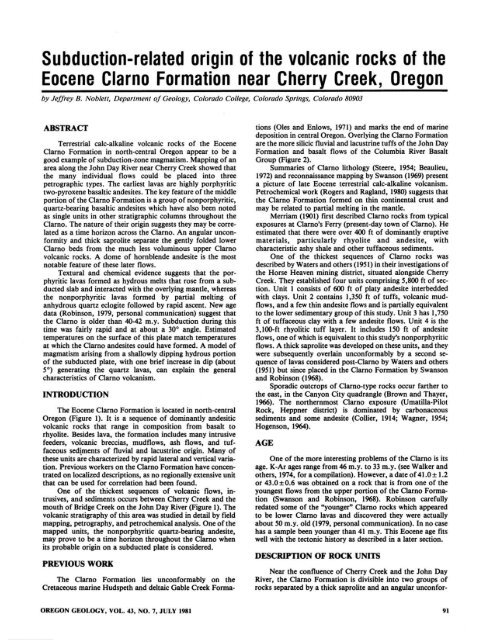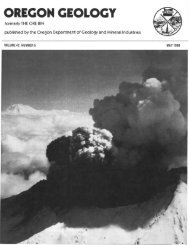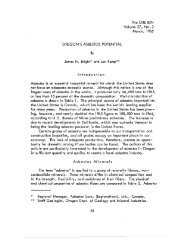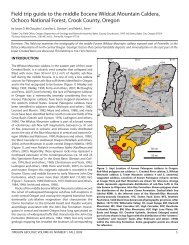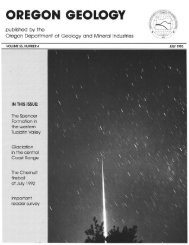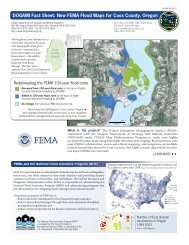Vol.43, no.7 (July 1981) - Oregon Department of Geology and ...
Vol.43, no.7 (July 1981) - Oregon Department of Geology and ...
Vol.43, no.7 (July 1981) - Oregon Department of Geology and ...
You also want an ePaper? Increase the reach of your titles
YUMPU automatically turns print PDFs into web optimized ePapers that Google loves.
Subduction-related origin <strong>of</strong> the volcanic rocks <strong>of</strong> the<br />
Eocene Clarno Formation near Cherry Creek, <strong>Oregon</strong><br />
by Jeffrey B. Nob/etl, Depaflment oj <strong>Geology</strong>, Colorado College, Colorado Springs, Colorado 8{)9{)3<br />
ABSTRACT<br />
Terrestrial calc-alkaline volcanic rocks <strong>of</strong> the Eocene<br />
Clarno Formation in nonh-central <strong>Oregon</strong> appear to be a<br />
good example <strong>of</strong> subduction-zone magmatism. Mapping <strong>of</strong> an<br />
area along the John Day River near Cherry Creek showed that<br />
the many individual nows could be placed into three<br />
petrographic types. The earliest lavas arc highly porphyritic<br />
two-pyroxene basaltic <strong>and</strong>esites. The key feature <strong>of</strong> the middle<br />
portion <strong>of</strong> the Clarno Formation is a group <strong>of</strong> nonporphyrilic,<br />
quanz-bearing basaltic <strong>and</strong>esites which have also been noted<br />
as single units in other stratigraphic columns throughout the<br />
Clarno. The nature <strong>of</strong> their origin suggests they may be correlau~d<br />
as a time horizon across the Clarno. An angular unconformity<br />
<strong>and</strong> thick saprolite separate the gently folded lower<br />
Clarno beds from the much less voluminous upper Clarno<br />
volcanic rocks. A dome <strong>of</strong> hornblende <strong>and</strong>esite is the most<br />
notable feature <strong>of</strong> these later flows.<br />
Textural <strong>and</strong> chemical evidence suggests that the porphyritic<br />
lavas formed as hydrous melts that rose from a subducted<br />
slab <strong>and</strong> interacted with the overlying mantle, whereas<br />
the nonporphyritic lavas formed by partial melting <strong>of</strong><br />
anhydrous quartz eclogite followed by rapid ascent. New age<br />
data (Robinson, 1979, personal communication) suggest that<br />
the Clarno is older than 40-42 m.y. Subduction durins this<br />
time was fairly rapid <strong>and</strong> at about a 30° angle. Estimated<br />
temperatures on the surface <strong>of</strong> this plate match temperatures<br />
at which the Clarno <strong>and</strong>esites could have formed. A model <strong>of</strong><br />
masmatism arising from a shallowly dippinS hydrous portion<br />
<strong>of</strong> the subducted plate, with one brief increase in dip (about<br />
5°) generatins the quartz lavas, can explain the seneral<br />
characteristics <strong>of</strong> Clarno volcanism.<br />
INTRODUCTION<br />
The Eocene Clarno Formation is located in north-central<br />
<strong>Oregon</strong> (Fisure I). It is a sequence <strong>of</strong> dominantly <strong>and</strong>esitic<br />
volcanic rocks that ranse in composition from basalt to<br />
rhyolite. Besides lava, the formation includes many intrusive<br />
feeders, volcanic breccias, mudflows, ash flows, <strong>and</strong> tuffaceous<br />
sediments <strong>of</strong> fluvial <strong>and</strong> lacustrine origin. Many o f<br />
these units ue characterized by rapid lateral <strong>and</strong> vertical variation.<br />
Previous workers on the Clarno Formation have concentrated<br />
on localized descriptions, as no regionally extensive unit<br />
that can be used for correlation had been found.<br />
One <strong>of</strong> the thickest sequences <strong>of</strong> volcanic flows, intrusives,<br />
<strong>and</strong> sediments occurs between Cherry Creek <strong>and</strong> the<br />
mouth <strong>of</strong> Bridge Creek on the John Day River (Fisure I). The<br />
volcanic stratigraphy <strong>of</strong> this area was studied in detail by field<br />
mappins, petrography, <strong>and</strong> petrochemical analysis. One <strong>of</strong> the<br />
mapped units. the nonporphyritic quartz-bearins <strong>and</strong>esite,<br />
may prove to be a time horizon throusJtout the Clarno when<br />
its probable origin on a subducted plate is considered.<br />
PREVIOUS WORK<br />
The Clarno Formation lies unconformably on the<br />
Cretaceous marine Hudspeth <strong>and</strong> deltaic Gable Creek Forma-<br />
OREGON GEOLOGY, VOL. 43, NO.1, J ULY <strong>1981</strong><br />
tions (Oles <strong>and</strong> Enlows, 1971) <strong>and</strong> marks the end <strong>of</strong> marine<br />
deposition in central Oreson. Overlying the Clarno Formation<br />
are the more silicic flu vial <strong>and</strong> lacustrine tuffs <strong>of</strong> the John Day<br />
Formation <strong>and</strong> basalt flows <strong>of</strong> the Columbia River Basa1t<br />
Group (Figure 2).<br />
Summaries <strong>of</strong> Clarno lithology (Steere, 1954; Beaulieu,<br />
1972) <strong>and</strong> reconnaissance mapping by Swanson (1969) present<br />
a picture <strong>of</strong> late Eocene terrestrial calc-alkaline volcanism.<br />
Petrochemical work (Rosers <strong>and</strong> Ragl<strong>and</strong>. 1980) suggests that<br />
the Clarno Formation formed on thin continental crust <strong>and</strong><br />
may be related to panial melting in the mantle.<br />
Merriam (1901) first described Clarno rocks from typical<br />
exposures at Clarno's Ferry (present-day town <strong>of</strong> Clarno). He<br />
estimated that there were over 400 ft <strong>of</strong> dominantly eruptive<br />
materials, particularly rhyolite <strong>and</strong> <strong>and</strong>esite, with<br />
characteristic ashy shale <strong>and</strong> other turraceous sediments.<br />
One <strong>of</strong> the thickest sequences o f Clarno rocks was<br />
described by Waters <strong>and</strong> others (1951) in their investigations <strong>of</strong><br />
the Horse Heaven mining district. situated alongside Cherry<br />
Creek. They established four units comprising 5,800 ft o f section.<br />
Unit 1 consists <strong>of</strong> 600 ft <strong>of</strong> platy <strong>and</strong>esite interbedded<br />
with clays. Unit 2 contains 1.350 ft <strong>of</strong> tuffs, volcanic mud·<br />
flows. <strong>and</strong> a few thin <strong>and</strong>esite flows <strong>and</strong> is partially equivalent<br />
to the lower sedimentary group <strong>of</strong> this study. Unit 3 has 1,750<br />
ft <strong>of</strong> tuffaceous clay with a few <strong>and</strong>esite flows. Unit 4 is the<br />
3.I00-rt rhyolitic tuff layer. It includes ISO ft <strong>of</strong> <strong>and</strong>esite<br />
flows, one <strong>of</strong> which is equivalent to this study's nonporphyritic<br />
flows. A thick saprolite was developed on these units. <strong>and</strong> they<br />
were subsequently overlain Unconformably by a second se·<br />
quence <strong>of</strong> lavas considered post-Clarno by Waters <strong>and</strong> others<br />
(1951) but since placed in the Clarno Formation by Swanson<br />
<strong>and</strong> Robinson (1968).<br />
Sporadic outcrops <strong>of</strong> Clarno-type rocks occur farther to<br />
the east, in the Canyon City quadrangle (Brown <strong>and</strong> Thayer,<br />
1966). The northernmost Clarno exposure (Umatilla· Pilot<br />
Rock, Heppner district) is dominated by carbonaceous<br />
sediments <strong>and</strong> some <strong>and</strong>esite (Collier. 1914; Wagner. 1954;<br />
Hogenson, 1964).<br />
AGE<br />
One <strong>of</strong> the more interesting problems <strong>of</strong> the Clarno is its<br />
ase. K·Ar ages range from 46 m.y. to 33 m.y. (see Walker <strong>and</strong><br />
others. 1974, for a compilation). However. a date <strong>of</strong> 41 .0 ± 1.2<br />
or 43 .0±0.6 was obtained on a rock that is from one <strong>of</strong> the<br />
youngest flows from the upper portion <strong>of</strong> the Clarno Formation<br />
(Swanson <strong>and</strong> Robinson, 1968). Robinson carefully<br />
redated some <strong>of</strong> the "younger" Clarno rocks which appeared<br />
to be lower Clarno lavas <strong>and</strong> discovered they were actually<br />
about SO m.y. old (1979, personal communication). In no case<br />
has a sample been younger than 41 m.y. This Eocene age fits<br />
well with the tectonic history as described in a later section.<br />
DESCRIPTION OF ROCK UNITS<br />
Near the confluence <strong>of</strong> Cherry Creek <strong>and</strong> the John Day<br />
River, the Clarno Formation is divisible into two groups <strong>of</strong><br />
rocks separated by a thick saprolite <strong>and</strong> an angular unconfor-<br />
"


